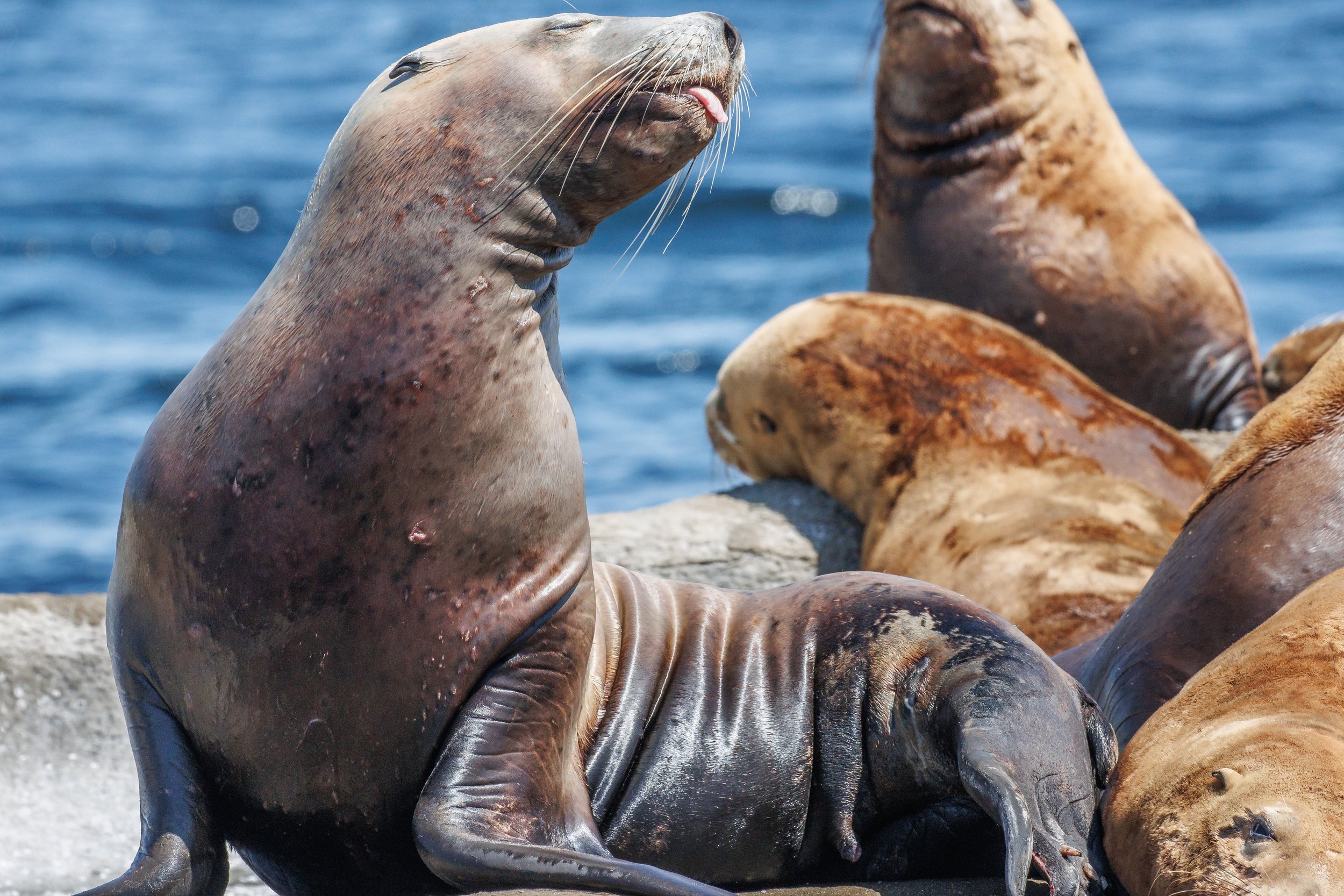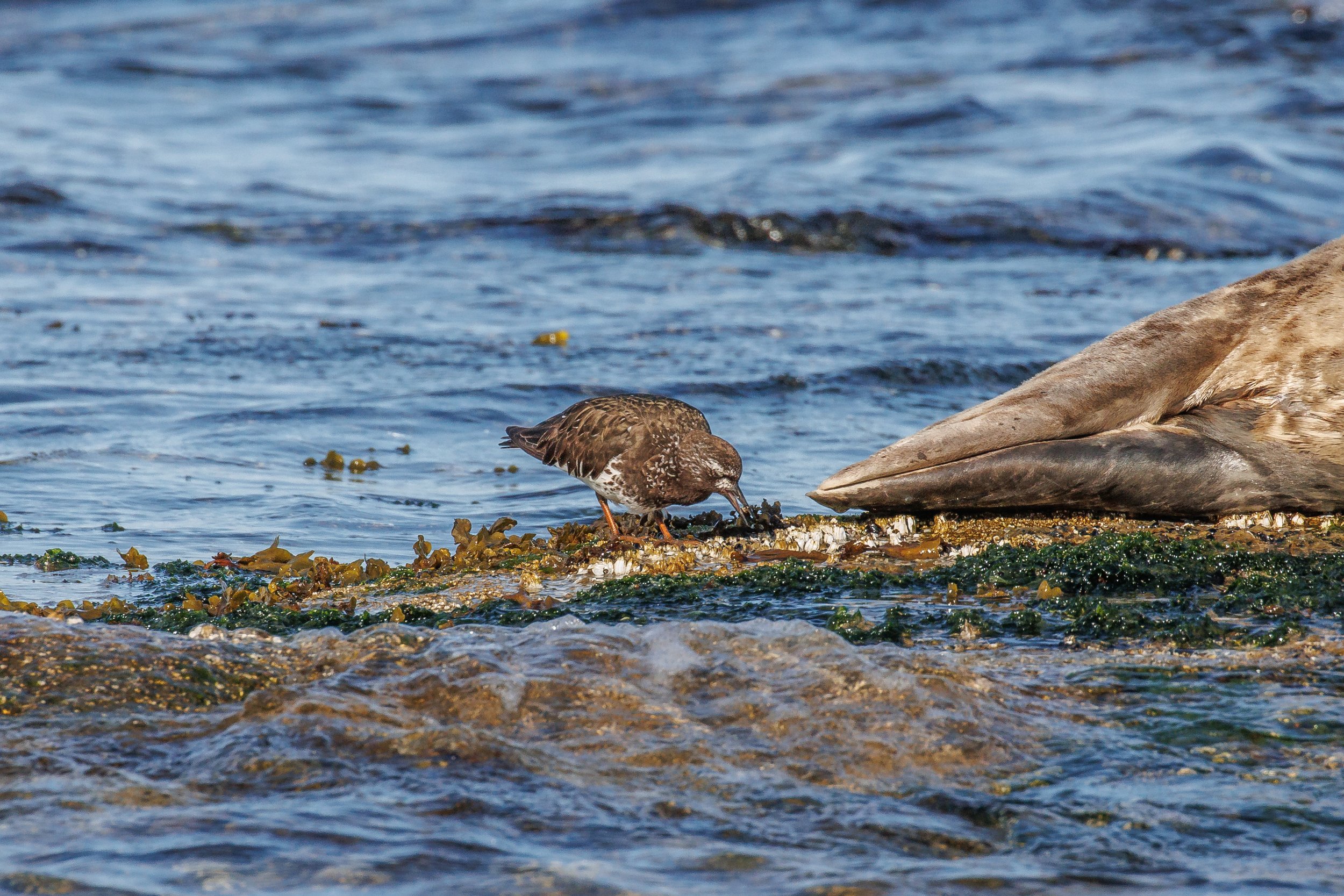July 26, 2023 - Anvil, Beak and an elusive Indy
It was another fin-tastic day on the water on July 26th! As we cruised along we got word that some humpbacks had been spotted off the Flattop Islands shortly after pushing off from the dock. We got on scene to find two humpbacks busy eating away. They were identified as:
Anvil (BCZ0410) and Beak/Nuage (BCX1606)!
Anvil needs to get nice and full before she makes her migration to her breeding/calving grounds in Hawaii this winter. While we are unsure where Beak migrates to, they also need to bulk up in preparation for their big trip to likely either Hawaii or Mexico. Humpbacks usually arrive in our area sometime between March and August and may stick around all the way until December - it really depends on how fast they can gain enough weight. Humpbacks rarely eat during their migration, so they rely on their summer feeding to keep them going until they return to our area again the following spring. This means they end up going on a multi-month fast, and if they gave birth in their breeding grounds, they would have a little calf to feed on the way back to the feeding grounds too!
Typically, humpbacks give birth to a calf every 2 to 3 years. Anvil’s most recent calf was born last year in 2022. It is possible that Anvil might be eating for 2 right now - we will have to wait and see if she brings back another bouncing baby next season!
After departing our humpbacks our boats started cruising to some of our favourite wildlife spots. We stopped at Stinky Rocks - an unofficially named rocky shelf that our pinnipeds like to haul out on. The sea lions were snoozing away in the summer sun as usual today. While most of our sea lions have migrated out of our area by now, we always have a small collection of sea lions who end up spending the whole year here.
We also spotted a small herd of Harbour seals resting on the rocks. We are right in the middle of pup season for our seals right now, and today we were lucky enough to see some of the adorable young ones beside their mothers!
After cruising away from our wildlife we entered into the protected waters of the Southern Gulf islands and began heading back north. We love taking this route as it showcases the beautiful landscape of the West Coast, and sometimes (if we are really lucky!) we are able to spot extra whales along the way. Today was one of those lucky days!…well, sort of at least.
As we crossed Ruxton Passage we spotted a splash in the horizon. We were unsure what it was so we went over to take a closer look. It turns out this was a fan-favourite orca, Indy!
T065A5 Indy ♂ (2014)
Unfortunately, Indy was being extra elusive today. He surfaced once, VERY quickly, and then vanished! Basically, he was the Salish Sea equivalent of the Loch Ness monster today. We tried to reacquire the tricky little whale but to no avail. After we left Indy we travelled north, cruised through Dodd Narrows, and headed back to home port.
Our afternoon tour was very similar to our morning tour. We tried to reacquire T065A5 Indy again, but he continued to be highly elusive and disappeared without a trace. While we are unsure where Indy was off to today, he seemed like he was on a mission as he was travelling very fast all day. Since Indy was being uncooperative, we headed over to Anvil (BCZ0410) who was busily feeding along the ferry lanes. This time Anvil was travelling quite fast, and surfacing very often. Her dive times were shorter than 2 minutes! To put it in perspective, dive times for humpbacks are typically closer to 5 to 12 minutes per dive, and humpbacks are able to hold their breath for up to an hour at a time.
After we left Anvil, we started cruising along towards the sunset. We stopped to see some seals and sea lions, as well as a little River Otter resting. To finish the tour off, we popped by the Gabriola Bluffs to visit our Cormorant rookery and a nearby eagle nest. While no one was home in our eagle nest in the morning, we were lucky enough to spot a couple of inhabitants this afternoon! Our eaglets (baby eagles) have now fledged (are able to fly) so they are becoming a bit rarer to spot during our trips, so we are always excited when they are hanging out in the trees overhanging the channel.
Photos by Marine Naturalists Cheyenne Brewster and Des Poier.
Did you know we can ID our humpbacks from the ventral side of their fluke? This one is Anvil! Photo taken during 10:30 tour by Cheyenne Brewster
Beak is a 9-year-old male humpback from Hawaii. Photo taken during 10:30 tour by Cheyenne Brewster
Anvil’s dorsal is much more pointy than Beak’s. Photo taken during 10:30 tour by Cheyenne Brewster
A side view of Anvil going for a deep dive. Photo taken during 10:30 tour by Cheyenne Brewster
Last year Anvil brought us her first calf! Photo taken during 10:30 tour by Des Poirier
Do you see the barnacles? A humpback can carry up to 1000 pounds of barnacles on its body at any given time. Photo taken during 10:30 tour by Des Poirier
Going for a nice deep dive. Photo taken during 10:30 tour by Des Poirier
Flukes up. Photo taken during 10:30 tour by Des Poirier
Do you see the large bump on Anvil? That’s a scar from a satellite tag. Photo taken during 10:30 tour by Des Poirier
Water cascading off a fluke as they go for a dive. Photo taken during 10:30 tour by Des Poirier
Anvil has a very white tail. Photo taken during 10:30 tour by Des Poirier
Beak going for a dive. Photo taken during 10:30 tour by Des Poirier
Beak’s tail is almost all black. Photo taken during 10:30 tour by Des Poirier
We swear this is an Orca. Indy was being extremely elusive. Photo taken during 10:30 tour by Des Poirier
Sealions have nails 1/3rd the way up their back fins. Photo taken during 10:30 tour by Des Poirier
Sealion with it’s tongue sticking out. Photo taken during 10:30 tour by Des Poirier
Stellar sealion scratching an itch with her teeth. Photo taken during 3:30 tour by Des Poirier
Everybody poops! Photo taken during 3:30 tour by Des Poirier
Mother harbour seal laying next to this year’s pup.Photo taken during 10:30 tour by Des Poirier
Look at this harbour seal’s fin, can you see the nails? Photo taken during 3:30 tour by Des Poirier
Harbour seal pup. Photo taken during 3:30 tour by Des Poirier
This is a river otter! People commonly mistake our river otters for sea otters. Photo taken during 3:30 tour by Des Poirier
Did you know bald eagles don’t get that white head and tail until they are around 5 years old? Photo taken during 10:30 tour by Cheyenne Brewster
The wind was blowing around this eagle’s feathers. Photo taken during 3:30 tour by Des Poirier
A juvenile bald eagle perched in a tree. Photo taken during 10:30 tour by Des Poirier
A turnstone next to a harbour seals back flipper. Photo taken during 3:30 tour by Des Poirier
Cormorants nesting on the Gabriola Bluffs. Photo taken during 3:30 tour by Des Poirier
Our cormorants have to dry off their wings before they go for a long flight. Photo taken during 3:30 tour by Des Poirier
A cormorant parent with their hungry chicks. Photo taken during 3:30 tour by Des Poirier
A beautiful shot of the Gabriola Bluffs. Photo taken during 3:30 tour by Cheyenne Brewster
Entrance island outside of Nanaimo. Photo taken during 3:30 tour by Des Poirier































